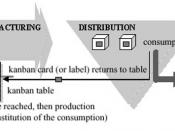JIT (just-in-time)
Many organizations throughout the world use JIT management principles in their everyday operations. It was first developed in Japan in the late 1950s by a former shop manager and later on vice president of Toyota. In its simplest form, JIT program is directed towards ensuring that the right quantities are produced or purchased at the right time, and that there is no waste. Waste is defined as anything that doesn't add value to the product or service. Producing one extra unit is as bad as being one unit short. Items are supplied only when needed, "just in time". JIT fits well under the specter of TQM, many of the ideas and techniques are similar, and JIT may even not work without TQM in operation. For JIT to work a number of elements must be combined: steady production, flexible resources, extremely high quality, no machine breakdowns, reliable suppliers, quick machine setups, and discipline to maintain that everything else is also functioning well.
JIT cannot be defined in one sentence but there are two ways at which it is usually looked at.
1. A series of operating concepts that allow systematic identification of operational problems.
2. A series of technology-based tools for correcting problems following their identification.
One outcome of using JIT is a program for improving overall productivity and reducing waste. This leads to cost-effective production or operation and delivery of only the required goods or services, in the correct quantity and at the right time and place. This is achieved with a minimal amount or resources: facilities, equipment, materials and people. Although JIT originated as an effort to eliminate waste it evolved into a system for the continuous improvement of all aspects of operations.
Aim of JIT
The aims of JIT are to produce and operate:
1. meet...


